- Home
- Peter Ackroyd
London: The Biography Page 9
London: The Biography Read online
Page 9
Fishermen laboured under hundreds of regulations about what they could catch, how they could catch, and where they could catch; the size and mesh of their nets were carefully measured. There was also an elaborate system of tolls and taxes, so that “Every man who brings cheese or poultry if the same amounts to fourpence halfpenny shall pay one halfpenny. If a man on foot brings one hundred eggs or more he shall give five eggs. If a man or woman brings any manner of poultry by horse and lets it touch the ground” he or she will pay more. It was an intricate system but its purpose was simply to ensure that the inhabitants of the city were adequately fed and clothed. It attempted both to pre-empt the extortionate demands of those who bought and sold, and to protect the rights of the citizens to trade in the city at the expense of “aliens” or “strangers.” The regulations had a further primary purpose, in the efforts to systematise trading so that there was little possibility of false measures, adulterated food or shoddy manufactures.
It is in the context of this thriving, colourful and energetic city that we can trace specific events which reveal the dangerous condition of the streets. In court records of the period we read of unnamed beggar women collapsing and dying in the street, of occasional suicides and constant fatal accidents- “drowned in a ditch outside Aldersgate … fell into a tub of hot mash.” We learn that “A poor little woman named Alice was found drowned outside the City wall. No one is suspected … a certain Elias le Pourtour, who was carrying a load of cheese, fell dead in Bread Street … a girl of about eight years old was found dead in the churchyard of St. Mary Somerset. It was believed that she was thrown there by some prostitute. No one is suspected.” Suicide in this age of piety, was considered a token only of madness. Isabel de Pampesworth “hanged herself in a fit of insanity” in her house in Bread Street. Alice de Wanewyck “drowned herself in the port of Dowgate, being non compos mentis.” Drunkenness was general, and there are continual references to citizens falling from their solars to the ground, falling down steps into the Thames, falling off ladders. The reports of these, and other fatalities, are to be found in The London Eyre of 1244 edited by Chew and Weinbaum. Other incidents are redolent of the period. “A certain man named Turrock” was found dead but “it was found that three men were lying in the deceased’s bed when he died … and they are in mercy,” the last phrase denoting that they had been acquitted of any charge. In another instance “Roger struck Maud, Gilbert’s wife, with a hammer between the shoulders and Moses struck her in the face with the hilt of his sword, breaking many of her teeth. She lingered until the feast of St. Mary Magdalen, and then died.”
This litany of death and disaster highlights the crude violence of the city streets; tempers are short, and life is held very cheap. “Henry de Buk killed a certain Irishman, a tiler, with a knife in Fleet Bridge Street, and fled to the church of St. Mary Southwark. He acknowledged the deed, and … abjured the realm. He had no chattels.” The quarrel of three men in a tavern by Milk Street led to a fatality when one was attacked with an “Irish knife” and a “misericord,” a merciful knife which was meant to guarantee a quick exit from this life; the fatally wounded man reached the church of St. Peter in Cheapside, but none of the bystanders offered to assist him.
The various trade guilds openly fought against each other in the streets; a group of goldsmiths, for example, fell upon a saddler and proceeded to lay open his head with a sword, chop off his leg with an axe and generally belabour him with a staff; he died five days later. When apprentices of the law rioted by Aldersgate, a citizen “amused himself” by shooting into the crowd an arrow which killed an unfortunate bystander. A “love-day,” designed to reconcile the coppersmiths and ironsmiths, turned into a general and murderous riot. When a group of unruly men entered a tavern one of the customers enquired, “Who are these people?” and was promptly killed with a sword. There were continual fights in the street, ambushes and arguments over nothing-or over “goat’s wool” as it was known. Games of “dice” or “tables” frequently ended in drunken fights, while it is clear that some of the owners of dicing taverns were engaged in wholesale fraud. It is a curious but instructive fact that the officers of the ward or parish were quick to tend to the religious needs of the maimed or dying, but there were few attempts to administer any form of medical treatment by physician or barber-surgeon. The injured were generally left to recover, or die, as providence intended.
There were many assaults upon women; in the transcripts there are cases of female Londoners being beaten or kicked to death, or callously murdered in premeditated fashion. Lettice accused Richard of Norton, vintner, of “raping and deflowering her” but the case did not proceed to trial. Wife-beating was common and went largely unremarked; but the brutalised women themselves could then in turn become brutal. A drunken woman started howling out insults to certain builders who were working on the corner of Silver Street-she called them “tredekeiles,” which might be translated as “lousy slobs,” and promptly started a fight in which one man was stabbed in the heart. Women could also be exponents of justice, rough even by London standards: when a Breton murdered a widow in her bed, “women of the same parish come owte with stonys and canell dong, and there made an ende of hym in the hyghe strete.”
The aldermen and watch of each ward had other duties which cast an intriguing light upon the customs of medieval London. They were instructed, for example, to arrest anyone wearing a “visor or false face” in the streets; to be masked was to be considered a criminal. The Court Rolls suggest that they were also given power to remove the doors and windows from any house of dubious reputation; there is a record of their “entering the house of William Cok, butcher, in Cockes Lane and tearing away eleven doors and five windows with hammers and chisels.” It is significant that the name, trade and street of the offender are conflated in characteristic medieval manner; it is an indication of how one activity, in this case the slaughter of poultry, can imbue an entire area of the city. Other incidents may also be representative, although less violent. The watch arrested certain apprentices who had filled a barrel with stones and then rolled it downhill from Gracechurch Street to London Bridge “to the great terror of the neighbours.”
There were more salacious, or intimate, events noted in the judicial records of a slightly later date; in their striking immediacy we might almost be in the same chamber with these early Londoners. “Will’m Pegden saieth that one Morris Hore broughte one Cicell and the saide Colwell had the vse of the bodie of the saide Elizabeth and the saide Alice Daie burned [gave a venereal disease to] the saide Cicell … And then the saide Alice daie came vppe Imediatlie, and lepped vppon the bed amp; said Cicell with hir kissinge together, and laying hir legges so broade that a yoked sow might go betwene.”
The crimes could be egregious, but the punishments had a distinctively communal aspect. It has often been suggested that the officials of the medieval city were more lenient than their successors in the seventeenth and eighteenth centuries, and there is a partial truth to this. Punishments such as amputation were often commuted. But the civic spirit could be violent indeed, at least when it was threatened, and there are many records of hanging or beheading for offences against the city’s peace. The fatal penalty was almost always imposed upon rebels and upon those offenders who had in some other way touched the king’s majesty; one man was hanged, for example, for tampering with the royal seal. The heads of rebels and traitors were boiled and placed upon London Bridge, sometimes adorned with a crown of ivy as a final theatrical touch in the drama of punishment. At times of tension or disorder within the city, also, the mayor and aldermen resorted to capital punishment as the most expeditious way of controlling the populace. Murder was always a hanging offence (except when committed by a woman who could prove herself to be pregnant) but, in more peaceful time, the prison and the pillory were the common remedies for crime. Walter Waldeskef was charged “with being addicted to playing knucklebones at night”; he was described in the report as “a night walker, well dressed a
nd lavish of his money, though no one knew how he got his living.” In the year after his arrest he was stabbed in Lombard Street and died in the church of St. Swithin at Walbrook. Agnes de Bury was imprisoned “for selling old fur on Cornhill,” while Roger Wenlock was committed to prison “for selling beer at 2d a gallon.” John Mundy, baker, “was set vpon the pyllery in Cornhill for makyng and sellyng of false breed,” and in the same month Agnes Deynte was also put in the pillory for selling “false mengled buttur.” Many and various frauds were also detected and punished. One baker cut a hole upon his moulding board; when the customer brought in his dough to be cooked, part of it was removed by a member of the baker’s family crouched beneath the counter. In another instance a former servant of a law officer, dismissed, travelled to various taverns and pretended to confiscate ale; the good tavern wives paid him to leave them alone. Eventually he was caught, and placed in the pillory.
Some of the punishments were more exotic. Bawds and “whore-mongers” had their hair shaved, leaving a two-inch fringe upon the heads of men and a small clump upon the heads of women. They were taken to their respective pillories by minstrels, the female pillory being known as a “thew,” where they became the target of the honest citizens’ anger or high spirits. If a woman was found to be a prostitute “let her be taken from the prison unto Aldgate” while wearing a hood of striped cloth and carrying a white taper in her hand; the minstrels once more led her to the pillory and, after the ritual abuse, she was marched down Cheapside and through Newgate to take up guarded lodgings in Cock Lane by West Smithfield.
Those consigned to the pillory for fraudulent manufacture or for selling shoddy goods had the items of their trade burned before them. John Walter had sold false measures of coal; he was condemned to stand in the pillory for an hour “with his sakkis brent [burnt] under him.” The journey to this place of obloquy was accompanied by other diversions: the culprit sometimes was forced to ride backwards on a horse, the tail towards him, and crowned with a fool’s cap. When one priest was found in flagrante delicto he was paraded through the streets with his breeches down and his clerical robes carried before him. Sir Thomas de Turberville, traitor, was taken through the streets of London dressed in a striped coat and white shoes; he was tied to a horse while around him rode six officials dressed all in red as emblems of the devil. Punishment becomes a form of festivity; in a relatively small and enclosed city, it turns into a celebration of communal feeling.
Yet harshness-one might almost call it savagery-was never very far from the surface, and can best be exemplified by the destination for London criminals who were spared the pillory or the noose: Newgate. During the coroner’s inquests of 1315-16, sixty-two of the eighty-five corpses under investigation had been taken from Newgate Prison. That is why there were many desperate attempts to break out of what was, essentially, a house of death. On one occasion the prisoners forced their way on to the roof “and faught ageyn the Citizens and kept the gate a greate while,” reinforcing the point that it was Londoners themselves who were essentially their guards and captors. It is perhaps appropriate, then, that one of the first extant texts in London English, written in the middle of the thirteenth century, should be entitled “The Prisoner’s Prayer.”
There was essentially only one escape from the wrath of the citizens, and that was the plea of sanctuary. A felon who could avoid capture, and take refuge in one of the many churches, was safe there for forty days. A watch was always placed around the church, in case of a sudden escape, and a body of citizens would have been encamped there day and night. Other places of sanctuary were Southwark, south of the river, and the east side of the Tower; where the power of the city stopped, in other words, the criminal was free. This is another indication of the self-sufficiency of the city, even if on such occasions it might have preferred a wider jurisdiction. During the course of sanctuary the prisoner often made a confession to the officers of the law and, at the end of the forty days, he or she was forced to “abjure the realm” and flee into exile. The status of the outcast was then announced at the folkmoot.
So from ancient deeds and coroners’ inquests, chancery rolls and chancery warrants, calendars of inquisitions and court records, we can summon up the spirit of medieval London in the streets, lanes and alleys that survive even still. But if this urban society was often characterised by violent confrontation so, too, was its political culture.
For much of the thirteenth century the record is one of riots, and massacres, and street-fighting. During this period London was in almost perpetual conflict with the reigning monarch, Henry III, while the aspiring leadership of the city was divided between the optimates and the populares- the old commercial magnates who had comprised the oligarchical commune of the city, as against the representatives of the crafts and trades who were beginning to feel their power. The situation was further complicated by the fact that the magnates tended to be royalist in their sympathy while the populares, sometimes also known as the mediocres, instinctively supported the barons of the realm with whom the king was in open conflict. London, once more, was the key. Whoever controlled the city was close to controlling the kingdom. The periodic baronial wars had this further consequence; there were parties and families within the city who maintained different allegiances, so that the national struggle was played out in miniature within the streets of London. It was truly the epitome of all England.
London Contrasts
A traffic “lock” or jam on Ludgate Hill, sketched by the French artist Gustave Doré towards the close of the nineteenth century.
CHAPTER 5. Loud and Everlasting
London has always been characterised by the noise that is an aspect of its noisomeness. It is part of its unnaturalness, too, like the roaring of some monstrous creature. But it is also a token of its energy and of its power.
From its earliest foundation London rang with the hammers of artisans and the cries of tradesmen; it produced more noise than any other part of the country, and in certain quarters, like those of the smiths and the barrel-makers, the clamour was almost insupportable. But there were other noises. In the early medieval city, the clatter of manufacturing trades and crafts would have been accompanied by the sound of bells, among them secular bells, church bells, convent bells, the bell of the curfew and the bell of the watchman.
It might be surmised that the effect of the bells ended with the Reformation, when London ceased to be a notably pious Catholic city, but all the evidence suggests that the citizens continued to be addicted to them. A German duke entered London on the evening of 12 September 1602, and was astonished by the unique character of the city’s sound. “On arriving in London we heard a great ringing of bells in almost all the churches going on very late in the evening, also on the following days until 7 or 8 o’clock in the evening. We were informed that the young people do that for the sake of exercise and amusement, and sometimes they lay considerable sums of money as a wager, who will pull a bell longest or ring it in the most approved fashion. Parishes spend much money in harmoniously-sounding bells, that one being preferred which has the best bells. The old Queen is said to have been pleased very much by this exercise, considering it as a sign of the health of the people.” This account is taken from The Acoustic World of Early Modern England by Bruce R. Smith, which offers an intimate version of London’s history. There is some suggestion here that the harmony of the bells is in some sense intended to demonstrate the harmony of the city, with the attendant “health” of its citizens, but there is also an element of theatricality or bravura intrinsic to London and Londoners. Indeed there is almost a kind of violence attached to their liking of loud sound. Another German traveller, of 1598, wrote that Londoners are “vastly fond of great noises that fill the ear, such as the firing of cannon, drums, and the ringing of bells, so that it is common for a number of them … to go up into some belfry, and ring the bells for hours together for the sake of exercise.” A chaplain to the Venetian ambassador similarly reported that London boys made bets
“who can make the parish bells be heard at the greatest distance.” To the element of display are added aggression and competition.
It is perhaps not surprising, therefore, that the very definition of the Londoner should be adduced in terms of loud noise. A Cockney was one who was born within the sound of the bell of St. Mary-le-Bow, in Cheapside, which according to John Stow was “more famous than any other Parish Church of the whole Cittie or suburbs.” Fynes Moryson, in 1617, announced that “Londiners, and all within the sound of Bow-Bell, are in reproach called Cocknies, and eaters of buttered tostes.” Bruce R. Smith has suggested that “cockney” in fact derives from the “cock-shaped weathervane” which once surmounted the belfry of St. Mary-le-Bow and that the Londoners’ identification with the sound came from their own “loud loquaciousness” or “boastfulness.”
As the city grew, so did its level of noise. By the beginning of the fifteenth century, according to Walter Besant’s London, “there was no noisier city in the whole world”; it could be heard from Highgate and from the Surrey hills. Dekker in The Seven deadly Sinnes of London evokes something of the incessant din-“hammers are beating in one place; Tubs hooping in another, Pots clinking in a third, water-tankards running at tilt in a fourth.” Here noise itself is associated with energy, and specifically with the making of money. Sound was intrinsic to the trades of the carpenters and the coopers, the blacksmiths and the armourers. Other occupations, such as dockers and porters, the loaders and unloaders by the wharves, actively employed noise as an agent of business; it was the only way of affirming or expressing their role within the commercial city.

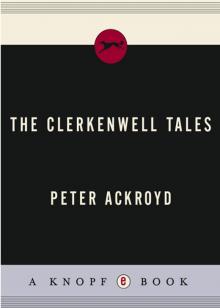 The Clerkenwell Tales
The Clerkenwell Tales The Canterbury Tales
The Canterbury Tales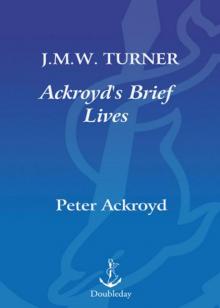 J. M. W. Turner
J. M. W. Turner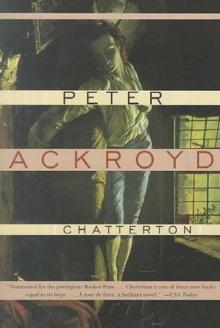 Chatterton
Chatterton The Canterbury Tales – A Retelling
The Canterbury Tales – A Retelling Alfred Hitchcock
Alfred Hitchcock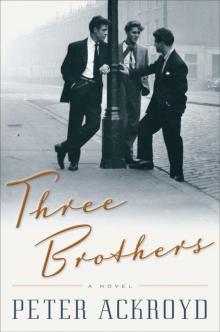 Three Brothers
Three Brothers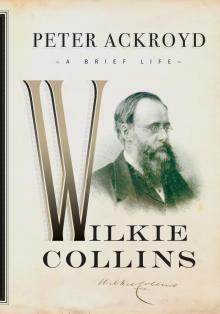 Wilkie Collins
Wilkie Collins Venice
Venice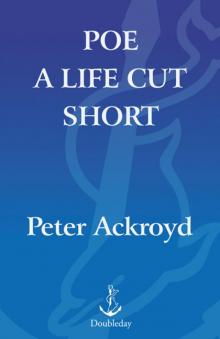 Poe
Poe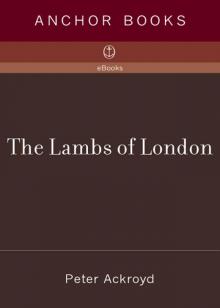 The Lambs of London
The Lambs of London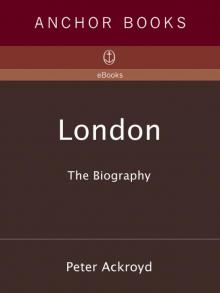 London
London Queer City
Queer City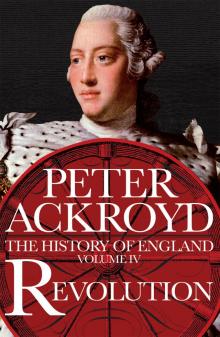 Revolution, a History of England, Volume 4
Revolution, a History of England, Volume 4 Venice: Pure City
Venice: Pure City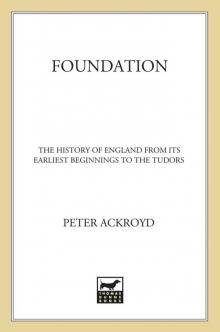 Foundation
Foundation Thames
Thames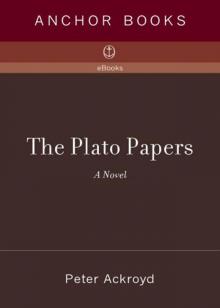 The Plato Papers
The Plato Papers The house of Doctor Dee
The house of Doctor Dee Rebellion: The History of England from James I to the Glorious Revolution
Rebellion: The History of England from James I to the Glorious Revolution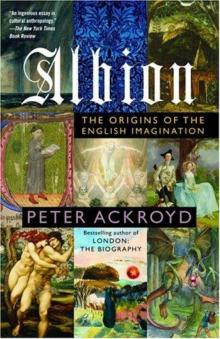 Albion: The Origins of the English Imagination
Albion: The Origins of the English Imagination The Fall of Troy
The Fall of Troy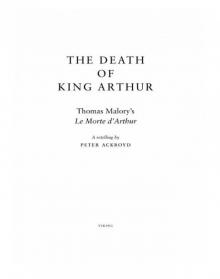 The Death of King Arthur
The Death of King Arthur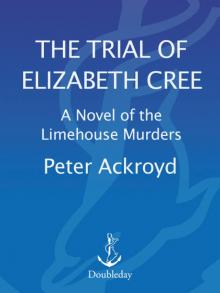 The Trial of Elizabeth Cree
The Trial of Elizabeth Cree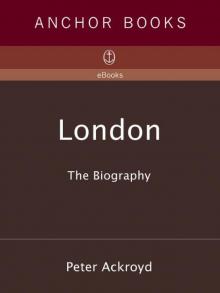 London: The Biography
London: The Biography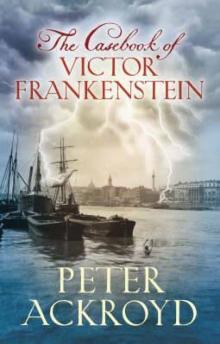 The Casebook of Victor Frankenstein
The Casebook of Victor Frankenstein Hawksmoor
Hawksmoor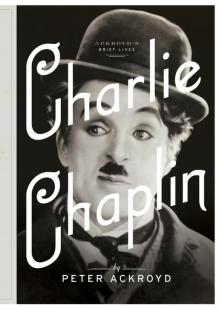 Charlie Chaplin
Charlie Chaplin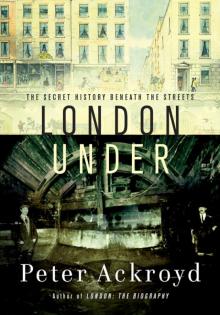 London Under
London Under